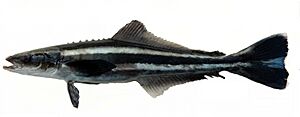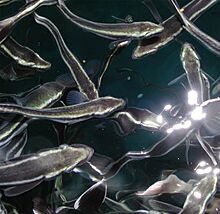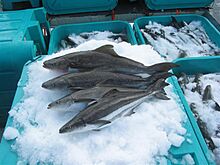Cobia facts for kids
Quick facts for kids Cobia |
|
|---|---|
 |
|
| Conservation status | |
| Scientific classification | |
| Genus: |
Rachycentron
|
| Species: |
canadum
|
| Synonyms | |
|
|
The cobia (Rachycentron canadum) (/ˈkoʊbiə/, koh-BEE-ə) is a cool ocean fish. It's the only living member of its group, called Rachycentron, and its family, Rachycentridae. People also call it by many other names, like black kingfish, lemonfish, or crabeater.
Contents
What Does a Cobia Look Like?
Cobia are long, sleek fish that can grow quite big. They can reach up to 2 meters (about 78 inches) in length and weigh as much as 78 kilograms (about 172 pounds).
Body Shape and Color
A cobia has a body shaped like a spindle, which means it's wider in the middle and tapers at the ends. Its head is wide and flat. It has small eyes and its lower jaw sticks out a little past its upper jaw. Inside its mouth, it has many tiny, brush-like teeth on its jaws, tongue, and the roof of its mouth.
The cobia's skin is smooth with small scales. It's usually dark brown on top, fading to white on its belly. It also has two darker brown stripes running along its sides. These stripes become even clearer when the fish is ready to spawn.
Fins and Tail
Cobia have large pectoral fins that they usually hold flat, which might make them look a bit like a shark. Their first dorsal fin has six to nine short, strong, sharp spines. These spines are why their family is named Rachycentridae, which comes from Greek words meaning "spine" and "sting."
Adult cobia have a forked tail that looks a bit like a crescent moon, and it's usually dark brown. Interestingly, cobia do not have a swim bladder, which is an organ that helps most fish float. Young cobia look different, with clear black and white stripes and a rounded tail.
The biggest cobia ever caught with a fishing rod weighed 60 kilograms (135 pounds). It was caught in Shark Bay, Australia.
How is a Cobia Similar to Other Fish?
The cobia looks a lot like its relatives, the remoras. However, cobia don't have the special suction cup on their head that remoras use to attach to other animals. Cobia also have a stronger, more solid body than remoras.
Where Do Cobia Live?
Cobia usually live alone, but they gather in groups once a year to spawn. You might find them around reefs, old shipwrecks, harbors, buoys, and other structures in the ocean. Even though they are pelagic (meaning they live in open water), they sometimes swim into estuaries (where rivers meet the sea) and mangroves to find food.
Ocean Homes
Cobia live in warm waters, from temperate to tropical areas. You can find them in the West and East Atlantic Ocean, all over the Caribbean Sea, and in the Indian Ocean near India, Australia, and the Pacific coast of Japan. Since 1978, cobia have also been seen in the eastern Mediterranean Sea. They likely got there either through the Suez Canal or by escaping from fish farms.
These fish are very adaptable. They can live in a wide range of temperatures, from very cold (1.6°C) to very warm (32.2°C). They can also handle different salt levels in the water, from slightly salty to very salty.
What Do Cobia Eat?
Cobia mainly eat crabs, squid, and other fish. They are clever hunters and sometimes follow larger animals like sharks, turtles, and manta rays. They do this to scavenge for leftover food. Cobia are also known to be very curious fish and don't seem to be scared of boats.
Who Eats Cobia?
We don't know all of the animals that hunt cobia. However, we do know that mahi-mahi (a type of dolphin fish) eat young cobia. Adult cobia can be eaten by shortfin mako sharks.
Cobia and Parasites
Cobia can sometimes have parasites. These tiny creatures can live on or inside the cobia. Some common types of parasites found on cobia include nematodes, trematodes, cestodes, copepods, and acanthocephalans.
Cobia Life Cycle
Cobia lay many tiny eggs, about 1.2 millimeters wide, directly into the open water. These eggs float freely with the ocean currents as part of the plankton. After the eggs hatch, the baby cobia (called larvae) are also planktonic. They are quite helpless for their first week until their eyes and mouths fully develop.
Male cobia become old enough to reproduce at two years old, and females at three years old. Both male and female cobia can live for 15 years or even longer. They gather in large groups offshore to breed from April to September. During this time, a female cobia can lay eggs up to 30 times in one season!
Where Do Cobia Travel?
Cobia make seasonal migrations, which means they travel to different places depending on the time of year. They spend their winters in the Gulf of Mexico. Then, as summer approaches, they swim north. They can travel as far as Massachusetts for the summer, usually passing Florida around March.
Cobia as Food
Cobia is a popular fish to eat. It has a firm texture and a great flavor, so it sells for a good price. There isn't a specific wild fishery just for cobia because they usually live alone. However, they are now being raised on fish farms.
Cobia meat is usually sold fresh. People often cook it by grilling or poaching the fillets. Famous chefs like Jamie Oliver and Mario Batali have even cooked with cobia on TV shows like Iron Chef America. The famous restaurant The French Laundry has also featured cobia on its special tasting menu.
Farming Cobia
Cobia are considered one of the best fish to farm in warm, open ocean waters. They grow very quickly, and their meat is high quality. This makes them an important fish for future fish farming.
Where Cobia are Farmed
Today, cobia are being raised in special nurseries and large cages in the ocean in parts of Asia, the United States, Mexico, and Panama. In Taiwan, young cobia are raised for about 1 to 1.5 years until they reach 6 to 8 kilograms. Then, they are sent to countries like Japan, China, North America, and Europe. About 80% of the ocean cages in Taiwan are used to farm cobia.
In 2004, a report showed that China and Taiwan produced over 80% of the world's farmed cobia. Vietnam is also a big producer. Companies like Open Blue off the coast of Panama run some of the largest open ocean fish farms for cobia.
Benefits of Offshore Farming
Farming fish in deeper waters, with stronger currents, and far from shore helps reduce the environmental problems that can sometimes happen with fish farms closer to land. These offshore cage systems could be a more environmentally friendly way to farm ocean fish.
However, there are still some challenges when farming cobia. For example, many fish can die from stress when they are moved from nursery tanks to the big ocean cages. They can also get sick from various diseases.
Cobia Diseases
Cobia can get sick from different types of infections caused by parasites and bacteria. Some common ones include Amyloodinium species, Photobacterium damselae subsp. piscicida, and Lactococcus garvieae.





